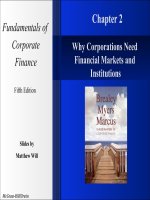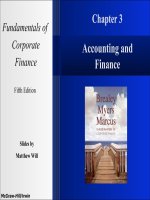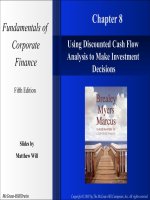Fundamentals of corporate finance 10e ROSS JORDAN chap008
Bạn đang xem bản rút gọn của tài liệu. Xem và tải ngay bản đầy đủ của tài liệu tại đây (1.55 MB, 85 trang )
Chapter 8
Stock Valuation
8-1
McGraw-Hill/Irwin
Copyright © 2013 by The McGraw-Hill Companies, Inc. All rights reserved.
Chapter Outline
•
•
•
•
•
8-2
Bond and Stock Differences
Common Stock Valuation
Features of Common Stock
Features of Preferred Stock
The Stock Markets
Chapter Outline
•
•
•
•
•
8-3
Bond and Stock Differences
Common Stock Valuation
Features of Common Stock
Features of Preferred Stock
The Stock Markets
Bonds and Stocks: Similarities
•
Both provide long-term funding for the organization
•
Both are future funds that an investor must
consider
•
Both have future periodic payments
•
Both can be purchased in a marketplace at a price
“today”
8-4
Bonds and Stocks: Differences
•
From the firm’s perspective: a bond is a long-term debt
and stock is equity
•
From the firm’s perspective: a bond gets paid off at the
maturity date; stock continues indefinitely.
•
We will discuss the mix of bonds (debt) and stock
(equity) in a future chapter entitled capital structure
8-5
Bonds and Stocks: Differences
•
A bond has coupon payments and a lump-sum
payment; stock has dividend payments forever
•
Coupon payments are fixed; stock dividends
change or “grow” over time
8-6
A visual representation of a bond with a
coupon payment (C) and a maturity value
(M)
1
$C 1
2
$C 2
3
$C 3
4
5
$C 4
$C 5
$M
8-7
A visual representation of a share of
common stock with dividends (D)
forever
1
$D 1
8-8
2
$D 2
3
$D 3
4
5
$D 4
$D 5
∞
$D
∞
Comparison Valuations
Bond
0
1
2
P0
C
C
3
C
M
Common Stock
0
P0
8-9
1
2
3
D1
D2
D3
D
∞
Notice these differences:
•
•
•
The “C’s” are constant and equal
The bond ends (year 5 here)
There is a lump sum at the end
1
$C 1
2
$C 2
3
$C 3
4
5
$C 4
$C 5
$M
8-10
Notice these differences:
•
•
•
The dividends are different
The stock never ends
There is no lump sum
1
$D 1
8-11
2
$D 2
3
$D 3
4
5
$D 4
$D 5
∞
∞
$D
Chapter Outline
•
•
•
•
•
8-12
Bond and Stock Differences
Common Stock Valuation
Features of Common Stock
Features of Preferred Stock
The Stock Markets
Our Task:
To value a share of
Common Stock
8-13
And how will we
accomplish our task?
8-14
8-15
B
Bring
A
All
E
Expected
F
Future
E
Earnings
I
Into
P
Present
V
Value
T
Terms
Just remember:
BAEFEIPVT
8-16
Cash Flows for Stockholders
If you buy a share of stock, you can
receive cash in two ways:
1. The company pays dividends
2. You sell your shares, either to
another investor in the
market or back to the
company
8-17
One-Period Example
Receiving one future dividend and one
future selling price of a share of
common stock
8-18
One-Period Example
Suppose you are thinking of purchasing the stock
of Moore Oil, Inc. You expect it to pay a $2
dividend in one year, and you believe that you can
sell the stock for $14 at that time.
If you require a return of 20% on investments of
this risk, what is the maximum you would be
willing to pay?
8-19
Visually this would look like:
1
R = 20%
D1 = $2
P1 = $14
8-20
Compute the Present Value
1
R = 20%
$1.67
$11.67
PV =$13.34
8-21
D1 = $2
P1 = $14
TI BA II Plus
1 year = N
-13.34
20% = Discount rate
$2 = Payment (PMT)
$14 = FV
1st
2nd
8-22
PV = ?
1 year = N
HP 12-C
20% = Discount rate
$2 = Payment (PMT)
PV = ?
$14 = FV
-13.34
8-23
Two Period Example
Now, what if you decide to hold the stock for two
years? In addition to the dividend in one year,
you expect a dividend of $2.10 in two years and
a stock price of $14.70 at the end of year. Now
how much would you be willing to pay?
8-24
Visually this would look like:
R = 20%
1
D1 = $2
2
D2 = $ 2.10
P2 = $14.70
8-25









